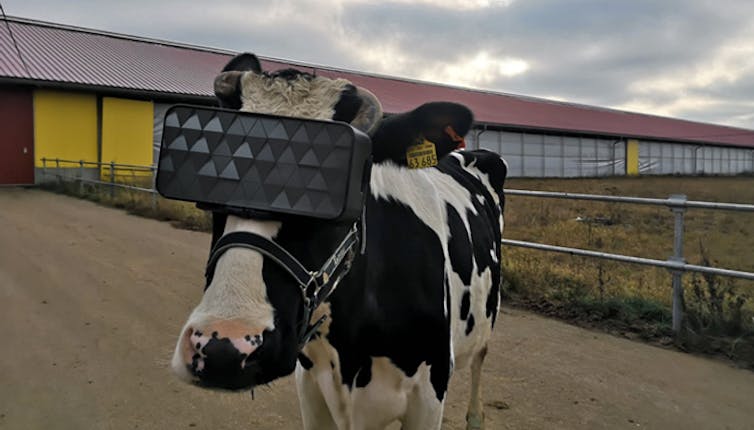Earlier this week, Russian farmers announced they are testing virtual reality (VR) for dairy cows.
Conducted at the RusMoloko farm near Moscow, the trials supposedly use specially adapted goggles to show the animals a view of a pleasant field in summer. The idea is to make the cows happier, which in turn could make them produce more milk.
Some have doubts over whether the tests are real, and it wouldn’t be the first time pictures of animals in VR headsets have been used to capture public attention. Similar images of CatVR and “virtual free range” chickens have appeared in the past.
But to take the idea seriously, at least for a moment: can animals perceive virtual reality the same way we do? And would it do them any good?

The grass may be greener in virtual reality, but you can’t eat it. Moscow Ministry of Agriculture and Food
Virtual entertainment for animals
Unfortunately for the emerging VR industry, there is little to suggest that gazing on a virtual landscape will make cattle happier.
Visual stimulation may be beneficial to some species of animals, but the research relates mostly to primates. Horses in a stable do seem to benefit from a view of other horses and an open window. But the sounds, smells, breeze and associated temperature changes in the real world make for a far richer sensory experience than VR can offer.
Could virtual reality for animals ever be a good idea? Cognition researchers working with chimpanzees have given the animals access to a virtual maze environment to study their spatial cognition abilities.
In this research the chimps were given food rewards when they successfully located objects in the maze. There’s no evidence they enjoyed the VR experience for its own sake. And the chimps didn’t wear VR headsets; the virtual world was displayed on a computer screen and the animals navigated using a joystick.
A visual VR experience might be appealing to humans, but would likely have less inherent value for animals. Humans can understand symbolic imagery, complex language-based events, and the written word. So visual technologies such as television, smartphones and VR can provide us with long-lasting entertainment, intellectual stimulation, and social connection.
This is not so for other species. While some dogs might watch TV, their interest is usually short-lived unless it has a meaningful outcome, such as the opportunity to chase and bark at animals on the screen. Similarly, some cats play with iPads and digital toys for short periods, but usually only keep up the behaviour if they are intermittently given a reward when they catch the “prey”.
Real entertainment for cows
Despite evidence that cattle have the capacity for complex thoughts and feelings, an increasing number of cows are housed year-round in relatively boring and restrictive indoor environments.
At the same time, there is interest in providing cattle with “environmental enrichment”. This takes the form of objects and activities to provide physical and mental stimulation, in the same vein as toys and puzzles for pets and zoo animals. As well as improving the animals’ well-being, it seems to improve dairy production outcomes.
Good animal enrichment addresses the physical and behavioural needs of different species that are not already met in their existing environment. Good enrichment can also give animals more agency – more control over their lives and their environment. For cows, enrichment might look more like a sophisticated brush than a VR headset.
Cows can choose how and when to use the brushing machine.
In our research, we have investigated approaches to designing technology-based enrichment that responds to animals’ real needs. In 2016 we trialled digital enrichment for orangutans at Melbourne Zoo, offering the animals a range of games and apps that could be made more complex as animals learn.
How tech for animals can change humans
There seems to be something inherently fascinating in seeing animals using technology that is “meant for humans”.
When we provided digital games for orangutans at Melbourne Zoo, we investigated the effect on visitors’ perceptions of the primates. We found that seeing the animals using technology influenced people’s empathy for the orangutans. Others have also proposed that digital games for pigs might encourage people to reflect on the needs of farm animals.
So while VR for cows may not directly improve their well-being, it just might encourage people to think more about what animals need.



 Shiba Inu on Edge: 69 Trillion Coins Test Market's Resolve as Prices Wobble
Shiba Inu on Edge: 69 Trillion Coins Test Market's Resolve as Prices Wobble  The politics stopping the UK from opening a youth mobility scheme with Europe
The politics stopping the UK from opening a youth mobility scheme with Europe  KT Innovates Media, Content Business Through AI
KT Innovates Media, Content Business Through AI  Why is China risking US sanctions by arming Russia?
Why is China risking US sanctions by arming Russia?  Our laser technique can tell apart elephant and mammoth ivory – here’s how it may disrupt the ivory trade
Our laser technique can tell apart elephant and mammoth ivory – here’s how it may disrupt the ivory trade  South Africa’s youth are a generation lost under democracy – study
South Africa’s youth are a generation lost under democracy – study  Solana Co-Founder Clashes with Vitalik Buterin, Champions Meme Coin Culture
Solana Co-Founder Clashes with Vitalik Buterin, Champions Meme Coin Culture  Tesla Model 3 Performance Price Surges Days After Debut, Cybertruck Powershare Costs Skyrocket
Tesla Model 3 Performance Price Surges Days After Debut, Cybertruck Powershare Costs Skyrocket  Elon Musk in Beijing to Propel Tesla's Self-Driving Tech in China
Elon Musk in Beijing to Propel Tesla's Self-Driving Tech in China  Shiba Inu Issues Alert: TREAT Token Scams Surge Amid Blockchain Upgrades
Shiba Inu Issues Alert: TREAT Token Scams Surge Amid Blockchain Upgrades  OpenAI and Worldcoin Eye Strategic Partnership Amid Regulatory Gaze
OpenAI and Worldcoin Eye Strategic Partnership Amid Regulatory Gaze  SHIB Burn Rate Soars 88% Following Major Shibarium Upgrade Announcement
SHIB Burn Rate Soars 88% Following Major Shibarium Upgrade Announcement  What is meaningful work? A philosopher’s view
What is meaningful work? A philosopher’s view  History for sale: what does South Africa’s struggle heritage mean after 30 years of democracy?
History for sale: what does South Africa’s struggle heritage mean after 30 years of democracy?  The planetary orbit in Netflix’s ‘3 Body Problem’ is random and chaotic, but could it exist?
The planetary orbit in Netflix’s ‘3 Body Problem’ is random and chaotic, but could it exist?  Musk Engages China: Baidu’s Data Deal and High-Stakes Hotel Meet with CATL
Musk Engages China: Baidu’s Data Deal and High-Stakes Hotel Meet with CATL 
































